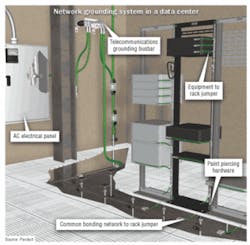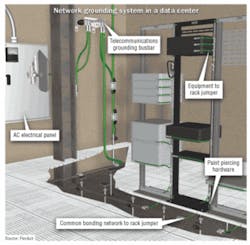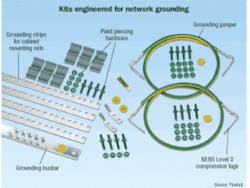Why grounding is critical to data center uptime
You can gain a competitive edge with your customers by understanding and then offering network grounding/bonding expertise.
Data centers need to achieve unprecedented levels of uptime to keep pace with modern business demands To achieve these uptime goals, data center managers are paying increased attention to facility infrastructure issues, including the network grounding system.
If you’re a contractor, understanding network grounding can give you a competitive edge by advising your customers on how to improve network availability.
Proper grounding of data center equipment, often called network grounding or the data center grounding infrastructure, is defined by TIA/EIA-942 Telecommunications Infrastructure Standard for Data Centers, and goes beyond the requirements of the National Electrical Code (NEC) to protect equipment and improve system reliability.
Grounding by tier
TIA-942 has adopted the tier definition provided by the Uptime Institute (www.upsite.com). Tier I is the lowest level, which allows 28.8 hours of site-caused information technology downtime per year. By contrast, Tier IV data centers used within financial institutions, Web hosting organizations, healthcare and others with the greatest need for critical uptime, have availability rates of 99.995%. This requires the data center be designed to experience only 0.4 hours of downtime annually-less than 5 seconds per day (Industry Standard Tier Classifications Define Site Infrastructure Performance, authored by W. Pitt Turner IV, John H. Seader, and Kenneth G. Brill and available at: www.upsite.com/file_downloads/PDF/Tier_Classifications.pdf). Building data centers to meet tier requirements is a complex process, encompassing expertise in a wide range of technical specialties, including architecture, cabling infrastructure, electrical design, environmental control, and fire protection. To make this task more manageable, TIA-942 provides design guidelines to help meet the uptime requirements of each tier level.
For example, when designing a Tier I data center, TIA-942 states, “A data center grounding infrastructure is not required, but may be desirable as an economic method to satisfy equipment manufacturers’ grounding requirements.” At Tiers III and IV, the data center infrastructure grounding system is absolutely required.
Contractors are ideally positioned to provide much of the network grounding system, and those who understand these requirements can provide a value-added service-the expertise to help customers understand and implement the necessary grounding system to improve their data center.
Network grounding design
The two goals of the grounding system are to equalize electrical potentials and to create a low resistance path to ground. Five basic principles are used when designing a grounding system to accomplish these goals:
1. The grounding system shall be intentional. Careful planning must be given to network grounding, just like any other system deployed in the data center. As the grounding system is no more reliable than its weakest link, only high-quality components can be used and trained professionals must make all connections.
2. The grounding system shall be visually verifiable. When implemented properly, you should be able to visually inspect every component of the grounding system, from the equipment, to the rack, to the common bonding network (CBN), to the earth. Such a system can be inspected for degradation and is accessible during moves, adds, and changes (MACs), ensuring long-term system reliability and scalability.
3. The grounding system shall be adequately sized. TIA-942 provides guidelines for each component of the grounding system. Improper use of the guidelines can reduce network availability and cause premature equipment failure that contributes to increased operating costs.
4. The grounding system shall direct damaging currents away from equipment. A grounding system that complies with TIA-942 requires each rack to bond directly to the CBN, thereby directing current away from sensitive electronics. For instance, a common error is to daisy-chain racks together. During a surge event, the entire row of daisy-chained racks becomes energized with stray current, potentially resulting in additional damaged equipment.
5. All metallic components in the data center shall be bonded to the grounding system. The goal is to have all conductive materials at the same electrical potential to minimize current flow. Current flows when there is a difference in potential between components. If the current flows across a piece of equipment, damage may occur. Equipment, racks, cabinets, ladder racks, enclosures, and cable trays must be bonded to the grounding system. (Additional information is available in the white paper, Facility Considerations for the Data Center, authored by American Power Conversion, Cisco Systems, and Panduit Corp.)
The grounding section of TIA-942 offers guidelines that meet the basic principles and adds additional details specific to the modern data center environment. One important issue is the creation of electrical continuity throughout racks and cabinets. Because most racks and cabinets are made of painted components that are bolted together, there is no guarantee that electrical continuity exists from one rack component to the next. In the data center, rack and cabinet continuity is important for safety; electrostatic discharge (ESD) protection; and the proper grounding of switches, servers, and power strips. Continuity may not exist if the installer fails to scrape paint between sections of rack or use specially designed paint-piercing hardware.
Network grounding installation
A licensed electrician is required to bond the AC power panel. Additionally, the electrician typically installs the busbar network throughout the building. The communications installer can complete the grounding of the busbar to the equipment. Often, electricians are hired to build the grid of CBN conductors under the raised access floor. Even in this case, little thought is given to how the grounding network bonds to the equipment.
Alarmingly, numerous data centers in operation today have grounding busbars in place, and a grid of CBN conductors under a raised floor, but not a single rack or cabinet bonded to the CBN. It is clear that the data center owner intended to have grounding; however, if the racks and cabinets are not bonded to the grounding system, then there is no protection. Creating electrical continuity within racks and cabinets is best accomplished during initial installation. This is also the best time to create the bond from the rack to the CBN before it is forgotten. Equipment that is installed on the racks should be bonded at this time.
It makes sense that the contractor who installs racks, cabinets, and equipment is in the best position to create the parts of the grounding system that go along with the installation. Collectively, this lets you be better positioned with customers by providing valuable information that educates data center decision-makers on how to protect their investment.
You should include a separate line item in bid submittals for upgrading to a TIA-942-compliant grounding system, even if the data center has not requested such an upgrade. This inclusion lets you make a competitive bid, to engage the customer in a conversation about TIA-942 grounding, and ultimately to create some distance from your competition.
Common problems and solutions
Data centers often run into trouble with their grounding systems when any of the following mistakes are made:
• Using the wrong type of grounding connectors. For example, connectors that use setscrews to fasten the conductor can loosen over time, degrading the electrical bond.
• Applying hardware, such as screws and washers, that are not designed to make an electrical bond, resulting in ungrounded equipment.
• Failing to create an electrical bond between the structural components of racks and cabinets can trap currents within sections of them, resulting in potential safety hazards, failure of ESD protection, and ungrounded equipment.
A kitted grounding system can help installers avoid the mistakes that plague data centers. Key features of a good grounding system should include:
• Permanent copper compression lugs that do not loosen over time;
• Hardware, such as thread-forming screws and paint-piercing washers, and studs that cut through the durable finishes that coat data center racks and cabinets, thereby creating a metal-to-metal connection (bond);
• Components, such as hardware and jumper cables, that are tested for their ability to create electrical bonds and carry current.
Additionally, the kitted system should comply with TIA-942 and fit any rack or cabinet that complies with the EIA-310D standard. Everything necessary to provide a TIA-942-compliant installation should be included in the kit, such as grounding strips, busbars, and jumpers for creating electrical continuity throughout a rack or cabinet; antioxidant to guarantee the long-term reliability of the electrical bonds; and instructions that describe the proper installation techniques (helps simplify ordering of grounding components and minimizes the risk of overlooking details).
Each component and connection in the system is critical to creating a low-impedance grounding path. In addition to using components that are listed by a nationally recognized testing laboratory, such as Underwriters Laboratories (UL), the jumper assemblies within the kits should also be listed to UL 467 Grounding and Bonding Equipment as a means of further certifying their applicability to grounding.
Ideally, components that make up the grounding kits are tested to determine their ability to function during real-world conditions, such as earthquakes, lightning strikes, and AC power faults. Telcordia Technologies’ NEBS Level 3 test of power connectors simulates response to these events and other scenarios that are likely in the data center environment. (For more information, see The Electrical Distributor, January 2004, “Minimize Service Interruptions.” www.tedmag.com). NEBS Level 3 is the most stringent test available to the industry, and power connectors that meet NEBS Level 3 should be specified for data centers at every tier level.
Business booster
Network grounding provides a win-win opportunity for you, and for data center managers. If you, as a contractor, understand the value of a well-designed system, you can provide expert consultative services and enhance your positioning as a valuable partner.
To avoid the problems that are common in network grounding systems, you should implement only engineered solutions that comply with accepted industry standards, such as TIA-942 and NEBS Level 3. And following proper network grounding practices will provide your customers with the highest level of network grounding capability.TOM TURNER is business development manager at Panduit Corp. (www.panduit.com).


